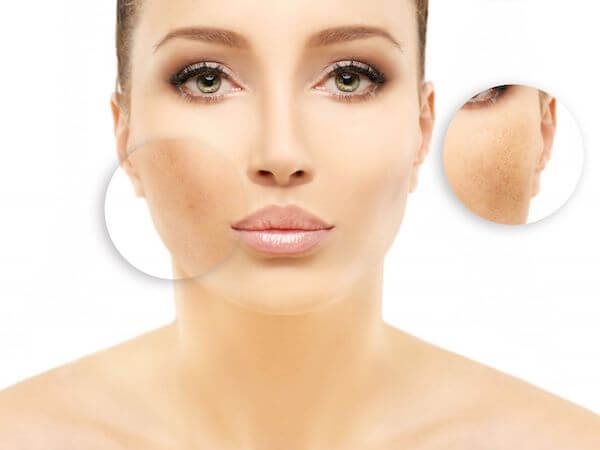Melasma happens when the melanocytes (brown pigmented skin cells) become overactive and produce too much color. The result is a splotchy brownish grayish mottled appearance of the skin. Although women most commonly suffer from melisma, about 10% of patients are male. Darker skin types have more active melanocytes and are therefore the more susceptible to having melasma.
Melasma is seen as brown or graying brown patches on the cheeks, forehead, nose, upper lip, or chin. Some people also get melasma patches on their necks and arms. Although there is no physical pain or discomfort associated with melasma, the appearance of the splotches can play an emotional toll and affect the confidence of the sufferer. Many women suffering from melasma will tend to over-apply thick makeup to cover the splotches, which can lead to additional skin problems.
SO WHAT CAUSES MELASMA?
Some common melasma triggers are sun exposure, hormonal changes, and irritation from skincare products.
Sun exposure is the main triggering factor for melanocytes. Our bodies developed melanocytes to protect our skin from harmful UVA and UVB rays. The more sun exposure you have, the more active your melanocytes become and it releases more and more dark pigment called melanin. But not all melanocytes are created equal. We can see the evidence of varying expression of melanocytes in the large array of skin types out there from dark to light, as well as the intermittent activities of freckles and sunspots. Melasma happens when there is a combination of sun exposure and the addition of one more factor… hormones.
SO WHAT DO HORMONES HAVE TO DO WITH IT?
Hormones are like your bodies chemical text messages. They are signals for your body to do certain things or react in certain ways. In the case of melasma, the hormones are telling the melanocytes that your body needs extra protection. Those melanocytes that both receive those messages and get exposed to sunlight will get hyperactive. This often causes that very blotchy patchy appearance to certain areas of your body.
There are many reasons for your body to send those extra hormonal signals to your melanocytes, but there is no bigger reason than pregnancy. Melasma and pregnancy so commonly happen at the same time that Melasma has been known as the pregnancy mask. Birth control pills will also cause a hormonal trigger that can cause melasma.
In addition, some products are irritants to your skin and create an inflammatory reaction. This can also cause the melanocytes to become hyperactive and overproduce melanin in the presence of the sun.
NOW THAT I HAVE MELASMA, WHAT CAN I DO TO GET RID OF IT?
Melasma can sometimes fade with time all on its own with very little effort. This spontaneous fading will happen over months and sometimes years. Some people, however, will have melasma for a lifetime, or for many years longer than they are willing to bear.
There are several topical chemicals that are prescribed to reduce the clearance of melasma.
Hydroquinone is often the first line of defense and is the most commonly prescribed treatment.
Tretinoin is also prescribed, sometimes alone, but also sometimes in addition to hydroquinone.
Phytoquinone or Kojic Acid are given to help round out the treatment and produce faster, more even results.
For stronger products that require a prescription, you will have to see your dermatologist or aesthetic medicine doctor. When topical chemicals are not enough to get complete clearance your dermatologist or aesthetic medicine provider may also prescribe treatments such as chemical peels, microdermabrasion, dermaplaning. In addition, a photo facial treatment or laser treatment may be recommended after proper skin conditioning or pre-treatment. A skincare consultation or a care concierge appointment will help you to figure out which treatments are right for you and your skin. Check out our services https://bergencountymedicalspa.com/medical-aesthetics-services-nj/
